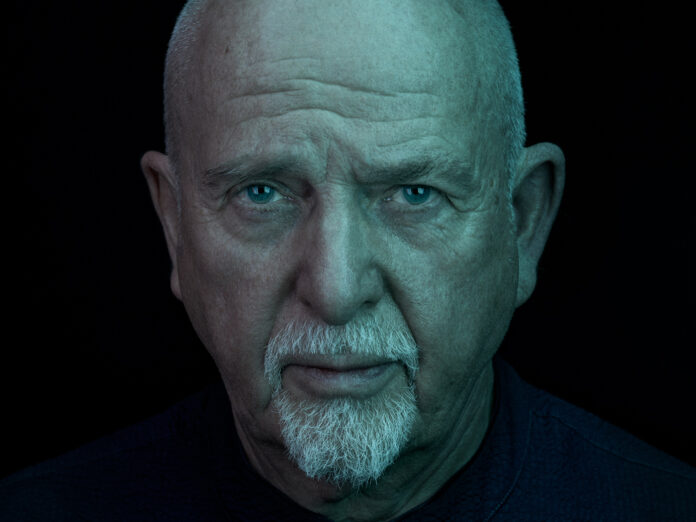Nowadays, so much of culture is available on demand that it is like being delivered art from a firehose. So it was an unusual move of Peter Gabriel to drip feed us his latest album – his first original studio LP in two decades – online over the course of 2023; releasing just a single track every four weeks.
Nowadays, so much of culture is available on demand that it is like being delivered art from a firehose. So it was an unusual move of Peter Gabriel to drip feed us his latest album – his first original studio LP in two decades – online over the course of 2023; releasing just a single track every four weeks.
Each came complete with artwork commissioned from a designated artist – including Ai Weiwei, Cornelia Parker, Annette Messager and Olafur Eliasson. Each came in two (very slightly different) mixes: a “dark side” mix by Tchad Blake and a “bright side” mix by Mark “Spike” Stent. It has turned his album into a series of events: a throwback to how we once experienced a great TV series – a scrap of brilliance tossed at us from time to time, leaving us hungry for more.
Order the latest issue of UNCUT now, featuring Bob Dylan and our bumper Review Of 2023
But even the millions of Gabriel fans who will have picked up these songs over the last year will not have been able to put these 12 discrete tracks into a context. Looking at them as a single body of work (albeit still released in ‘dark’/‘bright’ versions), what’s immediately apparent is how the album shifts steadily from a mood of misery and doom towards positivity and light. The first few tracks are mainly in a minor key and deal – obliquely – with issues of global injustice and environmental catastrophe; the latter tracks largely switch from the political to the personal, from the dystopian to the utopian. We start with songs about global justice, data mining and mass surveillance; we end with love songs and appeals to wisdom.
Gabriel has spent so much of the last two decades since his last original studio album curating his legacy – best-of compilations, live retrospectives, re-recording his lesser-known songs, getting others to record his more famous songs, recording covers of his favourite songs by other artists, and so on. In some ways, you could also see i/o as something of a compilation – your favourite elements of Peter Gabriel’s career, but reworked into wholly original material.
The heavy drums on the slow-burning dystopian openers, “Panopticom” (a lyric suggesting an inversion of Jeremy Bentham’s sinister, all-seeing “panopticon”) and “The Court” (a doomy appeal for social justice), draw parallels with the heavier tracks on 1980’s Melt, like “Intruder” and “No Self Control”.
“Road To Joy” is a terrific piece of bombastic digi-funk in the vein of “Shock The Monkey”, “Big Time” or “Steam”; while anyone who loves Gabriel’s big, widescreen ballads, from “Here Comes The Flood” to “Don’t Give Up”, will love “So Much” and “Love Can Heal”.
And, for those who could rightly claim that Gabriel’s albums since So have failed to deliver much in the way of a strong melody, there are plenty of songs here that are the equal of “Solsbury Hill” or “Sledgehammer”: the Randy Newman-style ballad “Playing For Time’, the sunny, optimistic title track “i/o”, the shimmering, singalong funk of “Road To Joy”.
Gabriel famously takes years on his projects. Partly it’s because he’s an obsessive tinkerer; partly it’s because he’s as interested in the process as the end. Sometimes this seemingly fruitless tinkering can filter down into results: “Four Kinds Of Horses” – a celebration of spiritual wisdom, set to twinkly, horror-movie tubular bells and a gothic beat – is a collaboration with Richard Russell of XL, something that started as an idea for Russell’s Everything Is Recorded a few years ago.
Meanwhile, the loping funk of “This Is Home” was apparently inspired by a brief but unused collaboration with DJ/producer Skrillex – instead of dubstep, it has birthed a machine-led funk groove that underpins a warm meditation on hearth and home. “As we struggle through the buzz and the grind/ Of one thing I’m certain/ I know this is home”. It’s a song that assists us in the move from political to personal, a transition completed by the penultimate track “And Still”, a lovely ballad where Gabriel deals with the death of his mother. “And still your hands feel cold/Those hands that brushed my hair”, he sings, poetically. “I’ll carry you inside of me”.
There are points where his relentless utopianism can sound trite. The final track, “Live And Let Live”, is an appeal for global understanding, set to a rolling two-chord groove and a Beatles-y cello riff. Its appeal to follow the wisdom of William Blake, Martin Luther King and Nelson Mandela is sincere and well-meaning but it’s rather glib to hear as complex conflicts rage around the world. Who, be it in Ukraine or Israel or Nagorno-Karabakh, is going to “lay your weapons down”? What does “it takes courage to learn to forgive, to be brave enough to listen” mean in a global context?
But, let’s face it, these are nice flaws to have. In an era where so many of our musical heroes seem to be growing more cantankerous and ill-tempered with age, it comes as a welcome relief to see one heritage act pushing positively into the future – and making some of the warmest and most joyous music of his career.



